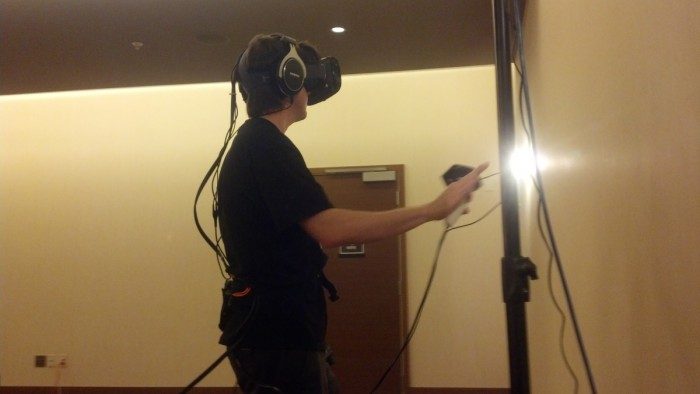Another experience shown was a 3D painting program called TiltBrush. Players drew 3D objects by moving the controllers around and holding down the triggers. As they moved the controller, a brush stroke was drawn in 3D space and seemed to hang in the air, able to be inspected from any angle. It was spectacular to see creativity pouring out onto the 3D virtual canvas found inside the Vive. Each person drew something completely unique and new which was a lot of fun to watch.

One thing that was surprisingly prevalent was an instinct to test out the boundaries of the SteamVR tracking system right from the start. This was nice to see, but potentially dangerous too. Although blinded from the real world while inside VR, people using the Vive were protected from bumping into walls thanks to the ‘Chaperone’ system; when the user ventured too close to an edge, a white grid popped up to let them know that they should back off or risk running into the drywall. Once that limit showed up, the typical reaction was to touch the boundary to make sure that it was real, rather than immediately running off in the other direction.
Road to VR’s Ben Lang had a similar reaction when testing the system:
After testing the boundaries of the space, and becoming confident that Chaperone is watching, you are free to believe that the virtual space you are walking around is real. I wasn’t in SteamVR for 5 minutes before I felt comfortable moving about without needing to distract myself with the location of real-world walls.

Not only did people have the urge to touch the virtual grid-wall they also seemed to want to explore their virtual environment with sudden movements. Kneeling on the ground was popular. The ability to fully walk around in a room-scale area produced amazing reactions. It was like watching a technological evolution happen before my very eyes. It was clear that VR was progressing forward well past the seated experience of the last few years. Now people are walking around in VR, touching the ground, and feeling the walls. It was unlike anything I had ever seen before; and I’ve seen a lot of virtual reality reactions over the last year or so—this was something special.
The VRLA Spring Expo had some great exhibitors, but the Vive stole the show. Just about everyone was talking about it. Not everyone that signed up got a chance to try it, which only increased the hype. The demand was so high that Valve sent down one of their employees to make sure the system demoed properly. If problems arose, the Valve employee would step in to correct.
By the end of the day, WEVR got roughly 50 people into the new VR system, far fewer than they would have liked, but with only one system and over 1000 requests to demo there was no way that everyone would be able to see it. Even with just five minutes per demo and five minutes between each session for setup, that would be more than 8 hours straight!
WEVR also recorded timelapse of all the demos, which can be seen in the video below. It was an amazing story to watch unfold. Note how many people approach the wall to verify that it’s really there.
For more information about WEVR’s work, be sure to visit their website. The company also recently launched a $1 Million VR Grant Program that virtual reality developers can apply for. They host open houses at their office monthly, which is definitely worth checking out. VRLA’s expos are hosted quarterly and you can sign up to be notified of their next event by subscribing to their mailing list online.
Road to VR is a proud media sponsor of VRLA









